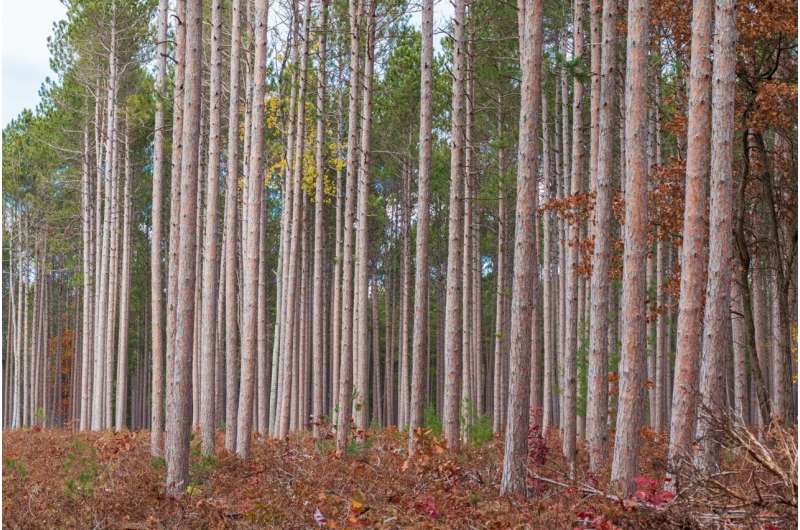Paying farmers to create woodland and wetland is the most cost-effective way to hit UK environment targets: Study

Incentivizing farmers to restore some land as habitats for nature could deliver UK climate and biodiversity targets at half the taxpayer cost of integrating nature into land managed for food production, according to a new study published today in the journal People and Nature.
This research is also being presented today at the British Ecological Society's annual meeting in Edinburgh by Professor Nicholas Hanley, an environmental ecologist based at the University of Glasgow.
The research, led by the universities of Cambridge, Leeds and Glasgow, provides the first evidence for the taxpayer savings offered by focusing food production in certain areas to allow the creation of new woods, wetland and scrub habitats on some of the land currently used for farming.
The study suggests that this "land sparing" approach would cost just 48% of the funds required to achieve the same outcomes for biodiversity and the climate through an approach known as "land sharing", where conservation measures get mixed into farming by adding hedgerows to fields, reducing pesticides, and so on—all of which lowers food yield.
Additionally, the researchers say that trying to share land with nature through making farming more wildlife-friendly would see the UK lose 30% more of its food production capacity than if farmers are encouraged to spare portions of land entirely for creating semi-natural habitats.
The UK government has legally binding commitments to reverse nature declines by 2030 and reach net zero carbon by 2050. Sparing land for habitats could hit these targets at half the cost of trying to farm on land shared with nature, say researchers.
"Currently, only a fraction of the £3.2 billion of public money annually paid to farmers goes on biodiversity and climate mitigation, some £600m a year," said Lydia Collas, who led the study as part of her Ph.D. at Cambridge's Department of Zoology.
"Almost all this fraction of funding supports land-sharing approaches that may do little to benefit species or sequester carbon, but do typically reduce food yields. Until now there has been no research on whether this is the most cost-effective solution to delivering environmental targets."
Cambridge's Prof Andrew Balmford, senior author of the study, said, "Greater incentives for farmers to create woodlands and wetlands will deliver for wild species and climate mitigation at half the cost to the taxpayer of the land-sharing approach that currently receives ten times more public funding."
The researchers say their findings—presented at the British Ecological Society's annual meeting by study co-author Prof Nick Hanley, an environmental economist from the University of Glasgow—should inform the current Brexit-prompted rethink of England's new Environmental Land Management Scheme (ELMs).
The researchers conducted a choice experiment study with 118 farmers responsible for 1.7% of all England's arable land, asking them to estimate the payments they would require to implement land-sharing practices or habitat-creating "sparing" approaches on their land.
Farmers chose from a variety of agricultural approaches, nature interventions and, crucially, payment rates. The study also considered the government's costs of administering and monitoring these schemes.
The team used three bird species—yellowhammers, bullfinches and lapwings—as a proxy for effects on biodiversity, as well a range of ways farmers could help slow climate change, such as woodland and hedgerow creation.
On average, farmers in the experiment accepted lower payments per hectare for land sharing practices. However, habitat creation schemes deliver far greater environmental outcomes per hectare, so creating woodlands, wetlands and scrublands would deliver the same overall biodiversity and climate mitigation benefits at half the cost to the taxpayer.
"We found that enough farmers are willing to substantially change their business to benefit from payments for public goods in the form of habitats, provided the government rewards them properly for doing so," said Balmford.
Collas, now a now a Policy Analyst at Green Alliance, added, "Existing evidence already shows that semi-natural habitats deliver far more biodiversity and climate mitigation per unit area, and creating them has far less impact on food production than meeting targets through land sharing."
"This evidence is dismissed when thinking about agricultural policy in the UK because of an untested assumption that farmers are unwilling to create natural habitat. We now have evidence showing this assumption is wrong."
More information: Lydia Collas et al, Paying farmers to create woodland and wetland is the most cost-effective way to hit UK environment targets, study suggests, People and Nature (2022). DOI: 10.1002/pan3.10422
Provided by British Ecological Society





















